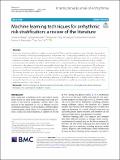Machine learning techniques for arrhythmic risk stratification: a review of the literature
Author(s)
Chung, Cheuk T.; Bazoukis, George; Lee, Sharen; Liu, Ying; Liu, Tong; Letsas, Konstantinos P.; Armoundas, Antonis A.; Tse, Gary; ... Show more Show less
Download42444_2022_Article_62.pdf (944.7Kb)
Publisher with Creative Commons License
Publisher with Creative Commons License
Creative Commons Attribution
Terms of use
Metadata
Show full item recordAbstract
Abstract
Ventricular arrhythmias (VAs) and sudden cardiac death (SCD) are significant adverse events that affect the morbidity and mortality of both the general population and patients with predisposing cardiovascular risk factors. Currently, conventional disease-specific scores are used for risk stratification purposes. However, these risk scores have several limitations, including variations among validation cohorts, the inclusion of a limited number of predictors while omitting important variables, as well as hidden relationships between predictors. Machine learning (ML) techniques are based on algorithms that describe intervariable relationships. Recent studies have implemented ML techniques to construct models for the prediction of fatal VAs. However, the application of ML study findings is limited by the absence of established frameworks for its implementation, in addition to clinicians’ unfamiliarity with ML techniques. This review, therefore, aims to provide an accessible and easy-to-understand summary of the existing evidence about the use of ML techniques in the prediction of VAs. Our findings suggest that ML algorithms improve arrhythmic prediction performance in different clinical settings. However, it should be emphasized that prospective studies comparing ML algorithms to conventional risk models are needed while a regulatory framework is required prior to their implementation in clinical practice.
Date issued
2022-04-01Department
Massachusetts Institute of Technology. Institute for Medical Engineering & SciencePublisher
BioMed Central
Citation
International Journal of Arrhythmia. 2022 Apr 01;23(1):10
Version: Final published version